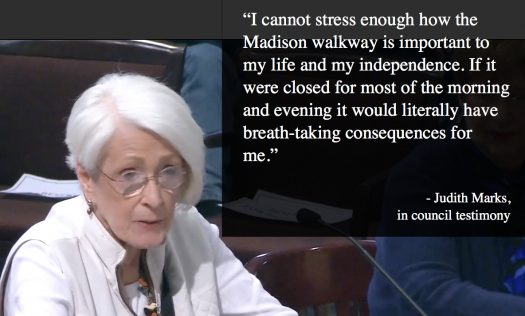 The Portland Art Museum says their $50 million expansion plans would create one of our city’s best public spaces — but it’s the existing public space they want to close that has put their project on shaky ground.
The Portland Art Museum says their $50 million expansion plans would create one of our city’s best public spaces — but it’s the existing public space they want to close that has put their project on shaky ground.
Portland City Council held its first hearing on PAM’s Rothko Pavilion project last week. At issue is whether or not the City should amend an existing public easement on SW Madison between Park and 10th that runs between the museum’s two main buildings. PAM’s new pavilion aims to connect the buildings with a new structure that would display art, host events, and serve as its main entrance. The public would be allowed to move through the new structure without buying a ticket; but access would be limited to museum hours (10:00 am to 5:00 pm Sunday through Wednesday and 10:00 to 8:00 pm Thursday and Friday) and people riding bicycles or walking dogs would be completely prohibited.
“When the museum brought this to me, I made it clear to them it would spark some controversy and concern and that it does fly in the face of some pretty specific Central City [Plan] policies around connectivity and accessibility.”
— Dan Saltzman, Portland City Commissioner
On Thursday of last week, museum representatives tried to make the case to Mayor Ted Wheeler and the rest of council that the benefits of museum expansion outweigh the loss of street connectivity and safety of people walking and biking in the area. After their invited testimony, 25 members of the public voiced their opinions. The vast majority (all but three or four) expressed passionate opposition and encouraged Council to require the museum to come up with a different design that would achieve their expansion goals and still maintain unfettered and unobstructed access.
This opposition came just a few days after we reported that the City of Portland’s Bicycle Advisory Committee and the Pedestrian Advisory Committee also oppose any change to the existing easement. At Council Thursday we learned that Oregon Walks and the Portland Commission on Disabilities are also in opposition.
Those warning flags were seen by Transportation Commissioner Dan Saltzman. In his introduction of the ordinance, Saltzman said he warned PAM their idea would not be popular. “I made it clear to them it would spark some controversy and concern and that it does fly in the face of some pretty specific Central City [Plan] policies around connectivity and accessibility,” he said. “They understood, and made a compelling case for a concept that strengthens central city policies around cultural institutions and innovation.”
Given a chance to make that case to the public, PAM Director Brian Ferriso said the new structure would help the museum offer better access and programming for its customers and that the new building itself would, “Serve as a visual invitation for the public.” Ferriso said maintaining an open walkway “is not possible.” “The entire space must be enclosed and temperature-regulated to protect the art,” he explained. “We believe this benefits the community in a deep and meaningful way.”
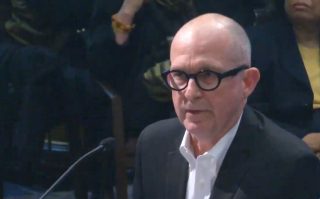
The museum’s Chief Advancement Officer JS May shared images of the proposed pavilion and said, “As you can see, leaving an 8-10 foot wide open-air easement between the buildings would result in a pavilion that doesn’t solve the problem of connectivity between our two buildings that it’s design to address. And designing gates or some other type of barrier would create security issues that would distract from the goal to create one of Portland’s grand public spaces.”
But the people who showed up to testify weren’t having it. And neither was Commissioner Amanda Fritz.
After Commissioner Nick Fish asked May if the proposal had any issues with the City’s Comprehensive Plan and May replied, “I don’t think so,” Fritz interjected: “There is testimony in the record from the West Quadrant Plan. Would you care to address those?”
“I don’t know the details deeply,” May replied, “So I’m not the person to address that.”
This was a curious exchange because Commissioner Saltzman said a few minutes earlier that he had already “warned” the museum that their proposal, “does fly in the face of some pretty specific Central City [Plan] policies.”
Fritz continued her questioning of May.
“The Planning and Sustainability Commission has asked about this. The pedestrian and bicycle advisory committees, Oregon Walks, and the Commission on Disabilities are all in opposition to this. Would you care to address those concerns?” she asked.
“There are definitely people who will be inconvenienced by the pavilion in the hours it is closed, we can’t deny that,” May replied. “The fundamental question is: Is the greater good of the city served by the pavilion being a destination for people and a public space, or is that not the case?”
To which Fritz replied, “But there is a public space there now which is really lovely.”
Fritz continued her skeptical line of questioning by saying her concerns are particularly about the safety of bicycle users who rely on the existing walkway (which is legal to bike on, because it’s not technically considered a sidewalk) as an alternate to SW Jefferson.
Advertisement
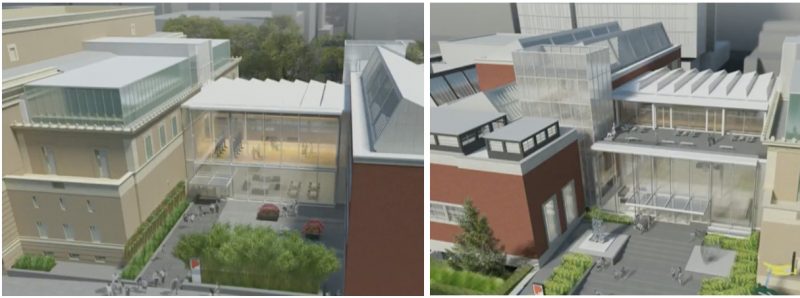
Once public testimony began, Council heard nearly two dozen people — most of them nearby residents and museum members/donors — object to the proposal. People not only want the plaza to remain unobstructed, they also accuse the museum of not listening to their concerns. The plans and approach taken by the museum thus far were called “elitist” and “arrogant”.
PAM member and supporter Wendy Rahm said the plaza is a “critical part of a larger pedestrian system” and that the museum’s expansion would “create a superblock and a physical and psychological barrier.” “There’s a ring of elitism to it,” she added.
Another PAM member, Katie Urey, said she was “very disappointed” that PAM needs to be lectured about the importance of connectivity and public access. “I’m embarrassed by the arguments of PAM,” she said, “I find them inward-looking and arrogant.”
A man who lives in the condominiums adjacent to the museum and who called himself a patron-level supporter of the museum said he and other neighbors met with PAM staff and architects over one year ago. “There must be a design solution that would allow an eight-foot wide passageway to stay open,” he said. Then he added, “I and others have requested they develop an alternative design, but our requests have never been taken seriously. I think the museum has felt they could just push their way through the planning process.” (It was pointed out that PAM has stated on their website that groundbreaking for the project would happen in 2018.)
“The connection matters in the network, it serves a function in the network, and it enhances the experience and delight of walking in our city… The importance of connectivity in the network cannot be overstated.”
— Ellen Vanderslice
One person invoked urban planning legend Jane Jacobs and said the museum’s pavilion would make the area less vibrant and less safe because it would encourage fewer “eyes on the street.” The name of Donald Trump also came up as one man described the proposal as a “wall to keep people out”.
Portland-based civil rights lawyer Lake Perriguey said the plans are akin to, “A wall and a travel ban in one.”
Ruth Ann Barrett, who runs the @PDXDowntowner Twitter feed and blog, said the proposal from PAM “has a landed-gentry feel to it” and that it’s “not drawing from the residents who live there.” She also poked at the museum’s name from the space. “To call it ‘The Commons’ is a bit of an exaggeration.”
At one point Commissioner Fish stepped in to encourage people to keep their testimony more respectful and to be nicer to museum staff. He never said which way he’d vote, but throughout the hearing Fish seemed very supportive of the museum. After Bicycle Advisory Committee member Elliot Akwai-Scott shared opposition to the plans, Fish asked him “Who is using this right-of-way for bicycle transportation?” “I’ve spent a lot of time in the area and have never seen a bike traverse this. It’s not what I would use,” Fish said.
Akwai-Scott informed Fish that he used the plaza a lot as a student at nearby Lincoln High School and then Portland State University. “I’d turn your question around and say, imagine how much more highly used this walkway would be if we didn’t have I-405 blocking the way. Every block is precious.”
The concern about precedent also came up several times. One nearby resident said his condominium wanted to close the public walkway on the adjacent block, but one of the reasons they fought (and won) to keep it open was because of the presence of the museum’s walkway. In other words, if the museum walkway closes, it would only be a matter of time before other property owners follow suit.
Another local resident, Mary Vogel, a self-described, “cyclist in that ‘female over-50’ category that planners are hard-pressed to attract to cycling,” said the Madison plaza route is her “safest and easiest path to the Hawthorne Bridge.” Vogel added that, “In an era of climate change and dwindling funds to repair the damage cars do to roads, we are a public benefit too!”
Perhaps the most persuasive testimony against the plan came from a retired PBOT staffer and widely recognized walking advocate Ellen Vanderslice. Vanderslice was the staffer who put together the city’s first Pedestrian Master Plan. “I’m here to oppose building a structure on Madison Plaza,” she said. “The connection matters in the network, it serves a function in the network, and it enhances the experience and delight of walking in our city… The importance of connectivity in the network cannot be overstated.”
After hearing about two hours sharp critiques, Commissioner Saltzman decided to refer the ordinance back to his office. “This will be continued,” he said. Saltzman’s Chief of Staff Matt Grumm said the issue might be back for consideration by council, “In about a month.” A briefing on the subject at the Planning and Sustainability Commission that was initially planned for today has also been postponed.
— Jonathan Maus: (503) 706-8804, @jonathan_maus on Twitter and jonathan@bikeportland.org
BikePortland is supported by the community (that means you!). Please become a subscriber or make a donation today.


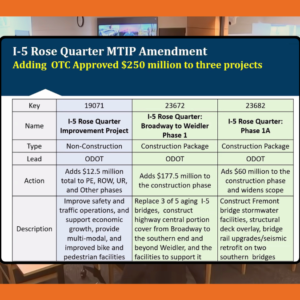
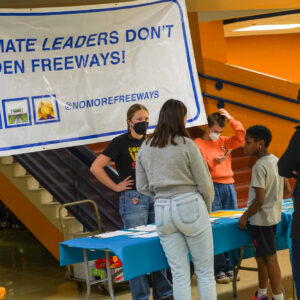
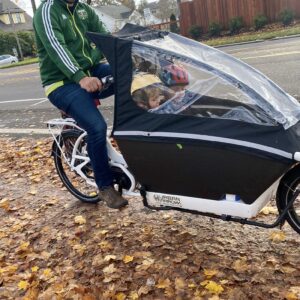
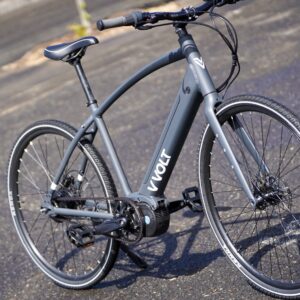
Thanks for reading.
BikePortland has served this community with independent community journalism since 2005. We rely on subscriptions from readers like you to survive. Your financial support is vital in keeping this valuable resource alive and well.
Please subscribe today to strengthen and expand our work.
First Fritz opposed biking on downtown sidewalks, and now she opposes this. When will the madness end?
Stop the assault on legs.
Museum is asking to take a public thoroughfare for the benefit of their members and themselves, regardless of the impact on people walking in the area. Basically stealing public land. Seems selfish.
With PAM’s proposal of the temporal closure of this public space for private uses…are they also making a corresponding proposal to pay rent for this temporal street “vacation” too?
I find it amazing that PAM has spent what looks like a lot of consulting money to have this design drawn up without considering the possibility of being denied the privilege of taking over a public space.
The architect told me that the firm created only one design which relied on the future grant of property rights. They made no contingency designs that would preserve public accessibility and the sculpture garden if the city council did not vote to give away $1,000,000+ in public assets to a private entity.
Good to know, and not surprising. Quite arrogant on the part of the client. I’d guess the architect is fully capable of designing something that would keep the ground level open, and be much more dynamic and appropriate than what the client allowed them to do.
Another PAM member, Katie Urey, said she was “very disappointed” that PAM needs to be lectured about the importance of connectivity and public access. “I’m embarrassed by the arguments of PAM,” she said, “I find them inward-looking and arrogant.”
Perfect summation. JS May, I believe, is a former BTA (Street Trust) board member, which makes his lobbying for this Design of Exclusion particularly egregious.
It’s dismaying that PAM leadership thinks they can sell what is essentially a small land-grab for their own little glass jewel box as something that “benefits the community in a deep and meaningful way.” Such brazeness! (As an aside, this is not only a failure to read of the temperature of our city, it’s also a failure of design; if you cannot develop a design that maintains the public easement, then you need a different architect and ideation.)
Uh, that was brazenness. Hate it when I forget that second N.
No problem. We all make mistakes, Shanon.
Well played. 🙂
If PAM wants to expand, let them use the next block to the north, the parking lot which they also own.
But where will the museum board members and staff park their Range Rovers?
I’d like to hear more about the precedent side of the issue as it relates to Voodoo Donuts (remember that Sisters of the Road and other groups opposed that for reasons of precedent.
PS-I’m the 1st “Josh G” -no avatar-
“…PAM Director Brian Ferriso said the new structure would help the museum offer better access and programming for its customers and that the new building itself would, “Serve as a visual invitation for the public.” Ferriso said maintaining an open walkway “is not possible.” “The entire space must be enclosed and temperature-regulated to protect the art,” he explained. …” bikeportland
Museum Director Ferriso feels that with a newly designed architectural connection between the museum’s buildings on the Madison St easement, maintaining and open walkway, is not possible? With all due respect, that viewpoint is astonishingly myopic.
Architects, engineers, artists and other creative people, could create a magnificent design that retained the entire 25′ width of Madison open to the public, rather than a puny 8′-10′ public way. The open walkway should be at least 15′ wide. That width would allow passage from both directions without feeling claustrophobic.
The museum most likely has rights to airspace, in which it could build a sky-bridge above the museum buildings. I’m glad to see in this story, additional visualizations of the proposed pavilion. From the west, the design is even worse than the it is from the east. Just to save face if for no other reason, the museum has got to come up with a far more inspiring design than the one it has come up with so far.
I suppose it all comes back to money. The museum probably doesn’t envision any chance of hiring a stellar architect, or one inspired by same, to build something extraordinary.
How could the closure of this walkway in the morning and evening have “literally breath taking consequences” for someone’s “life and independence”, and is the number of those people more than the single digits? Seems like hyperbole.
Because she suffers from Chronic Obstructive Pulmonary Disease (COPD) and she needs to limit her activity.
As I said, how many people does that describe?
I’m asking about persons who
1) have COPD or another condition that makes them unable to walk an extra 1.5 blocks (the distance of a detour around the building) AND
2) lives right by PAM (because if the person is walking from further away, then the extra 1.5 blocks can’t be a barrier) AND
3) walks daily to a destination right on the other side of PAM (because that’s the only reason they have to use the pavilion) AND
4) has to take those walks in the morning or evenings (because otherwise they could walk through the new facility).
Does that describe one person? Ten people?
For just about any project, you can come up with one or a few very sympathetic people who would be hurt. Analysis by anecdote is a weak process.
One person is enough. Who are you to dictate what is an acceptable impedance to someone with mobility issues? Shame on you.
Hi John,
Please keep in mind no one is holding up this one person and their health as the prime reason to object to this proposal. This is merely one element of many that bother people about this.
I agree with you that anecdotes are a terrible way to lead policy discussions — but that doesn’t mean people’s personal experiences shouldn’t be seriously considered.
Should we count up how many people stand to benefit on each side of the debate and then give the “win” to whoever comes up with the most? I don’t think that’s what either side wants.
I think the debate is going like it should. People are using existing planning policies to raise major concerns. Hopefully it leads to the best possible outcome — not for the museum or for people who live near it or for urban planning advocates — but for all of us as a City.
I prefer an analytical, data driven approach to decisions.
Let’s see data on how many people actually walk through this location during the hours when the museum would propose to close access, and how many of those people are genuinely physically unable to walk the alternate route which is about 1 block farther.
Suppose the data shows that 5 people a day would actually be greatly inconvenienced by closing the passage during those hours. Would it make sense to base major land use decisions on such an impact?
Again, virtually every project will be upsetting to someone. If we apply an emotional, knee-jerk, “shame on you” criteria, then we will block all projects.
Note that a person whose condition precludes walking an extra block is not going to be able to get around by bicycle or transit; their mobility, for distances greater than a couple of blocks, will depend on driving a car and being able to park close to their destination. But most people on this site have no problem with policies that impede auto use and remove parking. If someone in this condition testifies that parking should not be removed to install a protected bike lane, because their condition precludes them from walking multiple blocks from wherever they would be forced to park, will you all be so quick to stop the project then?
You’re making it sound like the only reason this proposal isn’t being approved yet is due to the sob stories of a few people. The reality is it goes against major City policies, which themselves weren’t put in place only to address the special needs of a few people. Even implying that “emotional, knee-jerk, “shame on you” criteria” are at play here is false.
And your “…then we will block all projects” comment doesn’t make sense. The number of projects that ask to build across public circulation routes is tiny, and the number that ask to enclose that space with walls and only let people through during business hours is even smaller. If the City denies EVERY project that asks to build across public circulation spaces, 99% of projects would still go ahead.
There are all kinds of valid, objective, unemotional reasons to deny requests to privatize public space and disrupt public circulation. And that’s AFTER the requestors prove that doing that is the only way to accommodate their needs, and that those needs outweigh drawbacks. The museum hasn’t even done either of those yet.
You are correct that virtually every project will upset someone, however, it is the project proponent’s responsibility to demonstrate to the decision makers that the project (or alternative projects) would minimize adverse impact to the surrounding area and populations. A valid concern was brought up by an individual during testimony and the Project Proponent did not have an “analytical, data driven” response. Even your comment suggests you are interested in the actual numbers of people affected based on a single person’s comment.
There is already a counter in the narrow area abutting 10th Avenue.
The impacts the closure has on the public is probably the key issue for deciding whether to approve this proposal. The impacts on the public are the sum of all the individual impacts. The only way to know what they are are for people to give their own personal stories. You can’t go directly to what the overall impacts on the public are. You have to start with individual stories.
I’m very skeptical that PAM couldn’t keep an open walkway through the pavilion. “The entire space must be enclosed and temperature-regulated to protect the art,” according to Director Ferriso. Of course. That’s what walls and windows are for. Build the pavilion, but run a street-level breezeway through it. That walkway we see in the concept art? Line it with windows. The museum’s buildings can still be connected on the basement, second and third floor levels, the art remains enclosed, and there would be plenty of room on the plaza level for a ticketing area and coat check.
It seems to me to be a very simple design solution, and the Museum’s excuses sound weak.
I agree with the other Douglas K.
If you are trying to build an entrance that also connects two buildings and serves as a welcoming space and probably a place for artwork and events , you want museum goers to be able to walk easily from that space into the two flanking buildings and to walk easily through the space to get from one building to the other. Having people enter then immediately climb stairs or take an elevator to a second floor passageway or down to an underground passage, just to start viewing the museum, wouldn’t make much sense. Not much point in building that at all.
PAM is the premier art museum in Portland and an important part of our cultural resources. The PAM building is also one of the most important pieces of architecture in our city, designed by one of our greatest architects. If PAM is going to spend a lot of money on an extension to the museum, it’ll want to do a really good job of it. If PAM had to end up with some weird ticket booth isolated from the rest of the museum, then why bother to invest the money?
Can you explain why they aren’t using the surface parking lot to the south that they own? I guess it’s more convenient to just steal public space, right?
Probably because it doesn’t connect their buildings.
Is the Art center’s nearby parking lot a gorgeous piece designed by a world-famous architect? If they want to expand, just do a de-pave event and building or plant something great.
They want to connect their buildings, which the parking lot would not do.
Sorry, it is actually to the north. All they have to do is get the city to vacate SW Main Street. That shouldn’t be a problem, as there are plenty of parallel streets nearby for vehicles and pedestrians to use. The art museum is a destination, after all. No one should need to drive past it.
Actually, it looks like PAM primarily wants to expand its interior space and it has simply chosen to focus on one option, connecting its two existing buildings, rather than consider alternatives. This MAY turn out to be the best option, but PAM has certainly managed to make it harder to sell by not seriously looking at other ideas and giving an honest assessment of the pros and cons of each, including costs.
Regardless of how important PAM is ultimately deemed to our cultural resources, the core questions remain:
Is their planned expansion genuinely beneficial to the community as a whole? Does the benefit of expansion outweigh the benefit of the current footprint of public space?
Is their expansion worthy of creating a precedent – one that undermines established and hard-won central city plan policies around connectivity and accessibility, and that removes access from what is now a public space and corridor?
The arguments presented by the museum itself are unsubstantial.
–
PAM Director Brian Ferriso said the new structure would help the museum offer better access and programming for its customers and that the new building itself would, “Serve as a visual invitation for the public.”
–
There is already “a visual invitation for the public” in the form of the inviting public space that the museum now wishes to reshape/eliminate.
That sums everything up well.
And of course the expansion will benefit its “customers” and serve as a “visual invitation”. But that doesn’t mean there aren’t other designs that would be much better–serving the museum while reducing impacts. In fact, the right design would be an improvement over what exists today. That’s what the city should hold out for, especially when what’s being proposed now is worse than what’s there already.
I would have liked the museum to show the City how they’d pursued (seriously, not in a token way) designs that wouldn’t block street-level access, and found that none could work. Since the museum played the game of “If you don’t let us do this design, we can’t do anything for our customers and we can’t create a visual introduction for the public”, then it’s perfectly legitimate to say, “Prove it”. Then–after that–come back and have the City decide whether the benefits outweigh the drawbacks.
Yes, if you want to do an addition that encloses the ground floor space between the two buildings, without concern for issues of public accessibility, this is a fine design.
“If PAM had to end up with some weird ticket booth…”? Why do you think that’s the best solution possible if the museum can’t do what they’re proposing now? Why do you give their architects such little credit for their ability to design something better? Why can’t they do as well as other museums have done elsewhere with similar constraints?
And your dire warning about how bad it would be to have to go up to the second floor to start your museum tour? That’s exactly how Seattle designed its new art museum in 1991, with a grand staircase, then again more recently, when it expanded and added a new entrance with an escalator–again up to the second floor.
Frank Lloyd Wright, one of history’s greatest architects, designed the Guggenheim in NYC–one of the world’s greatest museums–so that the museum tour starts at the TOP floor, then you work your way down.
So if the result of keeping the ground floor open is a compromised, “weird ticket booth” entry, that’s the museum’s fault. Examples all over the world show that keeping some ground floor space open isn’t a major problem.
I wrote each of the council members to oppose the barrier. I’m glad to hear the strong arguments for connectivity prompted a pause. But keep in mind it is just a pause. I’m going to write again to emphasize that the only acceptable design is one that allows 24 hour access for people walking, walking with a dog, or riding a bicycle.
Suppose a project that will benefit many, many people will cause great inconvenience to a single person. Should we stop the project?
It’s a fair hypothetical question (hypothetical because it doesn’t even come close to reflecting this museum situation).
The answer is that projects are stopped all the time because of one person, even if they won’t be inconvenienced at all, but just doesn’t like it for any arbitrary reason. It happens when the person or entity wanting to build the project wants to build it on land it doesn’t own or control legally, and the person who doesn’t like it has some claim to the land.
That’s exactly the situation here, so when the museum wants to remove or restrict a connection the public currently controls, the burden is on the museum to prove why its own interests outweigh others’ interests, even if the “other” is just one person.
If the museum were proposing to expand on land it owns, with no public easements on it, then I’d say the opposite–even if many, many people opposed the museum’s plans, it would be their burden to prove why the museum shouldn’t do what it wants on its own land.
Yes, the project should be stopped in that circumstance. Of course in this situation we’re not even talking about anything that has great importance, just more playground space for rich people.
The museum is only $5 on Friday evenings. About the same price as one of those rich-people beers they serve at your neighborhood bar.
Coming from the same mentality that everyone is rich enough to drive a car everywhere too.
Yeah, who cares about art, museums, and everything else that helps make a city a great place to live.
Weren’t the “Park Blocks” forever interuppted by a street vacating conversion? Once public space is vacated, it seems it never comes back to the people.
I brought it up before, but since it’s absent from the discussion again, I’ll point out PAM may be reacting to problems with transients, harassment, littering and vandalism on site. I likened it to the formerly pro-path people turning anti-path after what happened on the Springwater and elsewhere. We’re losing so many of the things that “help make a city a great place to live” because our spaces are–fairly routinely, now–being trashed and little substantive is being done to stop this trend. A museum has better cause than most institutions to worry about that kind of thing (vandalism). I appreciate John Liu’s comments and I don’t blame PAM at all for their proposal.
They may also be reacting to their own short-sightedness, arrogant disregard for the importance of connectivity and accessibility, and architectural ego, but we’ll never actually know, will we?
Have you spent time in this space? The museum already encroaches into this corridor with an outdoor enclosed pavilion. I am deeply opposed to them eliminating the remaining pass-through.
And I actually *DO* blame them for this proposal. They commissioned it, leadership bought into the talking points (“Serve as a visual invitation for the public.” is my fav) and now they’re doing a rather unimpressive job of rationalizing the need for it.
FWIW, I’m absolutely a fan of city-enhancing space making and architecture (Hello Kengo Kuma/Japanese Garden), and even of spectacle architecture when it achieves the same, but I am not a fan of gratuitous, ego-driven projects that think nothing of removing or infringing on established public space. That space has typically been very hard-won, we need to fight just as hard to preserve it.
And with that, I will direct my typings to city council.
Yeah, shannon, I have spent a lot of time using it, as I mentioned. Lived near there and it was part of my commute for a year and a half. Just raising a glaring issue I would guess is germane and that seems to be missing from the discussion here.
oops–apologies: I must’ve mentioned my living there on the other post.
I also think it’s a legitimate concern, but closing off the space is the wrong solution. Each time a public connection is lost, that makes it a bit more difficult to get around, and the various parts of the area a bit less connected. If other businesses and institutions take this approach (and approval of this one sets the precedent) then the area becomes that much more unfriendly for the general public, and that much more likely to move towards more harassment, vandalism, etc.
I also agree with Shannon–if this was the concern of the museum, they should have presented that to the City and public before doing much design work, and worked towards a solution other than rushing right into walling off the whole public space. And their “visual invitation” line was totally lame.
What is the solution, q? I confess, I’m at my wits’ end. What is the solution to public property—parks, trails, waterways—being routinely misused, vandalized and destroyed anymore? I’ve never voted down a greenspace (Metro) or Parks bond in my life until recently (the last election). Sick to death of pouring money into stuff that’s just going to get ruined. Sorry for the sidetrack. Can’t stand anymore to see what’s happened to the city I was born in, grew up in and loved. Cue violins. 😉
I know one thing–advocating violins is never a solution.
Better to attack with a cello.
Or a canon.
When I prepare for a fight I always pack a bell.
Ok, I’ll admit I don’t have the flair for this that you do.
Yo, hon! “Pack a bell” is classic!
You might want to make a note. If you do, the key is to always be prepared for an attack.
not only for an attack, but also for sharps and flats
Seriously, I don’t know.
Oh, it doesn’t matter because you made me laugh–you and Kitty both. 🙂 Is this how you got out of assignments in school, too?
Like asking the homemaking teacher where her lumber was? Or having the teacher write “incognito” on the board and asking what it meant and me saying I didn’t recognize it? No, I don’t remember anything like that.
I do remember a few pretentious kids trying to wall off part of the playground and getting in trouble.
Har! OK, everyone’s making me laugh now. And yes, q–like that. 🙂 I’m still smiling over pack a bell canon…
I do hope, before anything is built, and before any more information about this proposed addition appears in print, that PAM and The Oregonian–or wherever all this discussion is coming from–learn that “pavilion” has only one “L”. That said, it does seem to me that PAM should have considered other designs that wouldn’t impinge on the public’s use of public space.
If I had a dolar for every time I saw “pavillion” instead of “pavilion”, I’d be a milionaire.
You are cracking me up on this thread, sir!
If I had a million dollars for every time I heard that joke, I’d be a millionaire as well.
All I could think of was this design. Of course from The Netherlands. An art museum with a bike path going through it. (Because mobility is important over there.)
https://bicycledutch.wordpress.com/2016/05/31/the-bicycle-passage-of-the-amsterdam-rijksmuseum/
https://bicycledutch.wordpress.com/2013/07/18/bicycle-underpass-rijksmuseum-amsterdam/
They just gotta get a little more creative.
Yep!
I concerned by the absence of the Street Trust in this public conversation, particularly given their organization’s relationship to JS May. Are we (Street Trust members) to take away from this that relationships to donors and board members will be allowed to trump the actions that would fulfill the mission of the organization?
You can’t get much more disruptive to downtown circulation than to build a private lobby on a public circulation route, and not many projects try anything like that, so this seems like an odd one to stay silent on. Its silence on such a visible proposal could easily be interpreted to mean it had no concerns.
It’s especially true when JS May mentioned that he was a former board member of the Street Trust.
The opposition, and unwillingness to sacrifice a sliver of public space to create a larger art museum with more programs and exhibition space is exactly the kind of small-minded NIMBYism I’m starting to hate about Portland. This town is far too provincial and opposed to change in all its forms. This city should have a great art museum, and it shouldn’t be regarded as a “playground for the rich”, which is especially ironic, considering the values of the residential property in proximity to PAM. Who wouldn’t want a great art museum here, like the Art Institute of Chicago, or the Met? But no, having to walk a half-block further is a rallying cry for more opposition.
Sorry Portland, I hope my love of the outdoors and mountains in the region can keep me here, because the small town attitudes and small-minded anti-cosmopolitan attitudes here are not endearing you.
Why do nearby residential property values make it ironic to view the museum as a “playground for the rich”?
Why isn’t it possible to have a great art museum here without closing a street? Other, much better museums, have managed that all over the world.
Would closing the street have made the art museum great, like the Art Institute of Chicago, or the Met? No way.
If the museum doesn’t become great, will the requirement that the street be kept public be the reason why? Or one of the top ten reasons why? Unlikely.
The main reason the proposal didn’t get much support is that the museum tried to convince people that they had to choose between having a successful museum expansion, and keeping a public street public, because it wasn’t possible to have both. But they didn’t even bother to pursue (or at least show that they pursued) options that kept the street open. Clearly they convinced you, but fortunately not very many others.